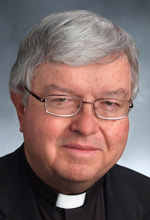Q. I have a friend who is driving me crazy about “reborn Christians.” That’s all he ever talks about, and he says that is the one way to salvation. I think he needs to be straightened out. Would you please give me all the information you have on this topic? (Huletts Landing, N.Y.)
A. The term “reborn” (or “born again”) is widely associated with evangelical Christianity and is used to describe a “conversion experience” in which a person consciously accepts Jesus as his or her personal savior. It is often linked with moments of deep emotional satisfaction.
In his book “Born Again,” Watergate conspirator Charles Colson describes such an experience while he was incarcerated. Having asked Jesus to come into his life and having committed himself to Christ, Colson writes, “With these few words … came a sureness of mind that matched the depth of feeling in my heart. There came something more: strength and serenity, a wonderful new assurance about life.”
The Catholic view links being “reborn” to the sacrament of baptism, referencing the words of Jesus to Nicodemus in the third chapter of John’s Gospel, where Christ equates being “born again” with “being born of water and Spirit.”
[hotblock]
The Catechism of the Catholic Church, in No. 1265, says, “Baptism not only purifies from all sins, but also makes the neophyte ‘a new creature,’ an adopted son of God.”
Since most Catholics were baptized as infants, as far back as they can recall they have believed, trusted and loved Jesus as savior and lord. They recognize that their baptism commits them to a gradual but lifelong deepening of their faith in Christ and holiness of life.
As to your friend’s contention that a “born-again” experience is the only route to salvation, I would refer him to the Second Vatican Council’s decree “Lumen Gentium.” In No.16, the document explains that “those who, through no fault of their own, do not know the Gospel of Christ or his church, but who nevertheless seek God with a sincere heart, and, moved by grace, try in their actions to do his will as they know it through the dictates of their conscience — those too may achieve eternal salvation.”
Q. Why should a priest put the creche in the back of the church? We happen to have a small church with no side altars, and for years our pastor placed the Christmas crib in front of the church, to the side of the main altar. That way, one would be able to kneel at the altar rail to pray while viewing the crib.
But we have a new priest now, and he has the crib in the back of the church. I have been a parishioner here for all but seven of my 84 years, and this is the first time this has ever happened. Why is there no room on the sanctuary floor for the Christ Child, who is the center of our lives? (Atlantic City, N.J.)
A. It’s a bit difficult to answer without knowing the exact size and proportions of your church’s sanctuary area. I can tell you, though, that the main focus of a church should always be the altar, since that is where the sacrifice of Christ is offered and where Christ becomes present.
Consistent with that, the General Instruction of the Roman Missal, in No. 299, says the altar should have ample room for the ministers of the Mass to walk around. More specifically, a document devoted to church art and architecture (“Built of Living Stones”), issued by the U.S. Conference of Catholic Bishops in the year 2000, explains that “the altar should remain clear and free-standing, not walled in by massive floral displays or the Christmas crib.”
At the same time, the Christmas crib is clearly a valued object of devotion and should be placed where families can draw near to it with ease. It may be that in its new position in your parish church, it is now even more accessible than it was when people knelt at the Communion rail to view it.
***
Questions may be sent to Father Kenneth Doyle at askfatherdoyle@gmail.com and 40 Hopewell St., Albany, NY 12208.
PREVIOUS: Where is the fire of Catholicism?
NEXT: Changing a child’s godparents; Mass for an aborted child




Share this story